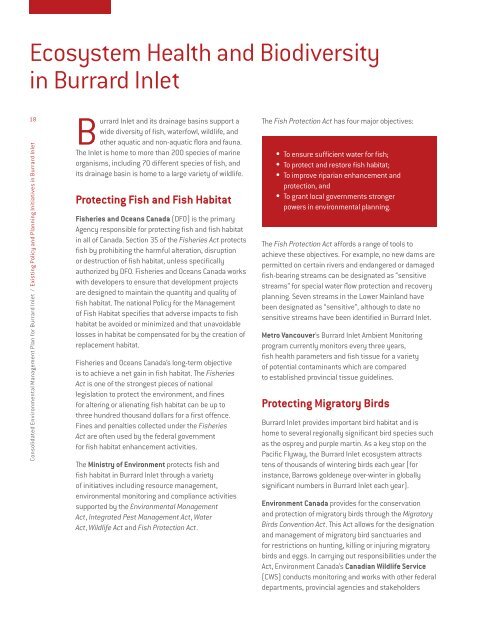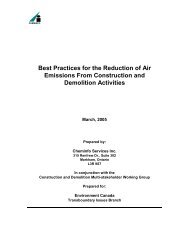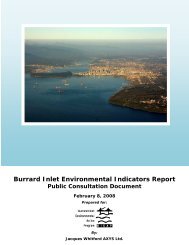Consolidated Environmental Management Plan for Burrard Inlet ...
Consolidated Environmental Management Plan for Burrard Inlet ...
Consolidated Environmental Management Plan for Burrard Inlet ...
You also want an ePaper? Increase the reach of your titles
YUMPU automatically turns print PDFs into web optimized ePapers that Google loves.
Ecosystem Health and Biodiversity<br />
in <strong>Burrard</strong> <strong>Inlet</strong><br />
18<br />
<strong>Consolidated</strong> <strong>Environmental</strong> <strong>Management</strong> <strong>Plan</strong> <strong>for</strong> <strong>Burrard</strong> <strong>Inlet</strong> / Existing Policy and <strong>Plan</strong>ning Initiatives in <strong>Burrard</strong> <strong>Inlet</strong><br />
<strong>Burrard</strong> <strong>Inlet</strong> and its drainage basins support a<br />
wide diversity of fi sh, waterfowl, wildlife, and<br />
other aquatic and non-aquatic fl ora and fauna.<br />
The <strong>Inlet</strong> is home to more than 200 species of marine<br />
organisms, including 70 different species of fi sh, and<br />
its drainage basin is home to a large variety of wildlife.<br />
Protecting Fish and Fish Habitat<br />
Fisheries and Oceans Canada (DFO) is the primary<br />
Agency responsible <strong>for</strong> protecting fi sh and fi sh habitat<br />
in all of Canada. Section 35 of the Fisheries Act protects<br />
fi sh by prohibiting the harmful alteration, disruption<br />
or destruction of fi sh habitat, unless specifi cally<br />
authorized by DFO. Fisheries and Oceans Canada works<br />
with developers to ensure that development projects<br />
are designed to maintain the quantity and quality of<br />
fi sh habitat. The national Policy <strong>for</strong> the <strong>Management</strong><br />
of Fish Habitat specifi es that adverse impacts to fi sh<br />
habitat be avoided or minimized and that unavoidable<br />
losses in habitat be compensated <strong>for</strong> by the creation of<br />
replacement habitat.<br />
Fisheries and Oceans Canada’s long-term objective<br />
is to achieve a net gain in fi sh habitat. The Fisheries<br />
Act is one of the strongest pieces of national<br />
legislation to protect the environment, and fi nes<br />
<strong>for</strong> altering or alienating fi sh habitat can be up to<br />
three hundred thousand dollars <strong>for</strong> a fi rst offence.<br />
Fines and penalties collected under the Fisheries<br />
Act are often used by the federal government<br />
<strong>for</strong> fi sh habitat enhancement activities.<br />
The Ministry of Environment protects fi sh and<br />
fi sh habitat in <strong>Burrard</strong> <strong>Inlet</strong> through a variety<br />
of initiatives including resource management,<br />
environmental monitoring and compliance activities<br />
supported by the <strong>Environmental</strong> <strong>Management</strong><br />
Act, Integrated Pest <strong>Management</strong> Act, Water<br />
Act, Wildlife Act and Fish Protection Act.<br />
The Fish Protection Act has four major objectives:<br />
• To ensure suffi cient water <strong>for</strong> fi sh;<br />
• To protect and restore fi sh habitat;<br />
• To improve riparian enhancement and<br />
protection, and<br />
• To grant local governments stronger<br />
powers in environmental planning.<br />
The Fish Protection Act af<strong>for</strong>ds a range of tools to<br />
achieve these objectives. For example, no new dams are<br />
permitted on certain rivers and endangered or damaged<br />
fi sh-bearing streams can be designated as “sensitive<br />
streams” <strong>for</strong> special water fl ow protection and recovery<br />
planning. Seven streams in the Lower Mainland have<br />
been designated as “sensitive”, although to date no<br />
sensitive streams have been identifi ed in <strong>Burrard</strong> <strong>Inlet</strong>.<br />
Metro Vancouver’s <strong>Burrard</strong> <strong>Inlet</strong> Ambient Monitoring<br />
program currently monitors every three years,<br />
fi sh health parameters and fi sh tissue <strong>for</strong> a variety<br />
of potential contaminants which are compared<br />
to established provincial tissue guidelines.<br />
Protecting Migratory Birds<br />
<strong>Burrard</strong> <strong>Inlet</strong> provides important bird habitat and is<br />
home to several regionally signifi cant bird species such<br />
as the osprey and purple martin. As a key stop on the<br />
Pacifi c Flyway, the <strong>Burrard</strong> <strong>Inlet</strong> ecosystem attracts<br />
tens of thousands of wintering birds each year (<strong>for</strong><br />
instance, Barrows goldeneye over-winter in globally<br />
signifi cant numbers in <strong>Burrard</strong> <strong>Inlet</strong> each year).<br />
Environment Canada provides <strong>for</strong> the conservation<br />
and protection of migratory birds through the Migratory<br />
Birds Convention Act. This Act allows <strong>for</strong> the designation<br />
and management of migratory bird sanctuaries and<br />
<strong>for</strong> restrictions on hunting, killing or injuring migratory<br />
birds and eggs. In carrying out responsibilities under the<br />
Act, Environment Canada’s Canadian Wildlife Service<br />
(CWS) conducts monitoring and works with other federal<br />
departments, provincial agencies and stakeholders
















